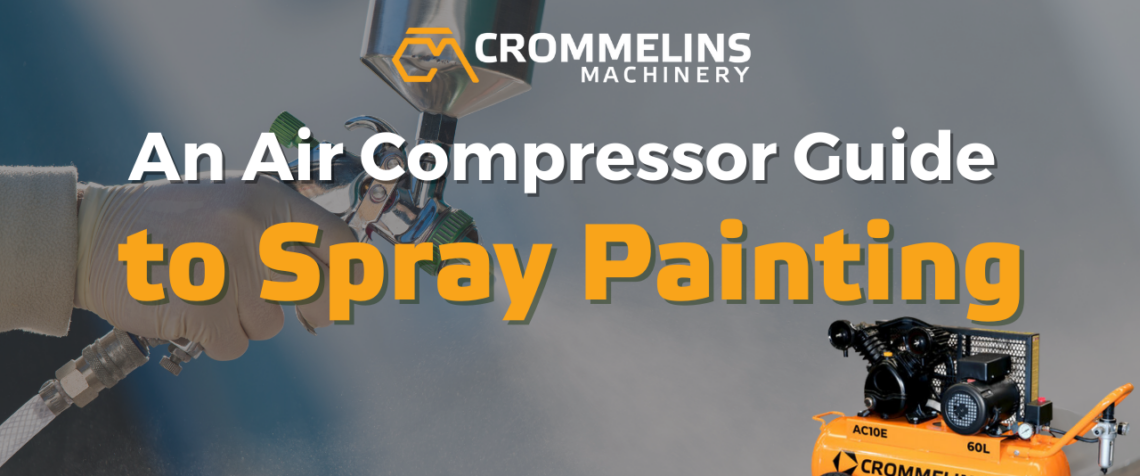Air compressors are used to power a wide range of pneumatic tools, and one common use is for spray painting. Using a compressor for spray painting provides precise control over air pressure and paint flow, resulting in a consistent and high-quality finish compared to other methods.
Common air paint spray guns use a delivery mechanism called “high volume, low pressure” (HVLP) to deliver paint across surfaces. It is important to select the right air compressor to match the pressure and volume requirements for your specific painting area, desired speed, and finish quality.
This blog discusses what air compressor requirements you should consider and how to set up your air compressor for spray painting.
Air Compressor Requirements for Spray Painting
When it comes to choosing an air compressor for spray painting there are three factors you should consider before making a purchase: the pound per square inch (PSI), cubic feet per minute (CFM) and the size of the air compressor storage tank.
Pound Per Square Inch (PSI): The term ‘low pressure’ in HVLP implies that spray painting doesn’t demand high-pressure settings, but it’s still essential to maintain an acceptable PSI level to ensure consistent coating.
Cubic Feet Per Minute (CFM): This factor is crucial when choosing your compressor since it indicates both the air volume generated per minute by the compressor and the specific volume of air at a given PSI. It’s essential that the compressor’s CFM rating exceeds that of your air spray gun to minimise pressure drop and volume loss, which can lead to uneven coverage. To determine the required CFM, consult your paint gun’s manual, as this value varies between different models.
Tank size: Your air compressor needs to have enough storage capacity so it can operate at the pace of your spray gun. As your spray gun needs a steady and uninterrupted flow of air, it’s essential that your compressor is appropriately sized to ensure a seamless painting process.
What size compressor do I need for spray paint?
Horsepower: For light applications and portable trade, a 1-2 horsepower will be sufficient. Industrial spray painters would need a horsepower of 3 and above. Ensure that you have the correct CFM and PSI for your model.
CFM: Typically, most spray guns require a 10 CFM or lower, although a rating of 12 CFM and above is also common. Professional painters may require an even higher CFM rating. The key is to ensure that you’ve thoroughly checked your spray gun’s CFM requirements and selected a compressor that exceeds that specification.
Pressure (PSI): For HVLP spray guns, PSI typically falls within the range of 25-30 PSI but where a high fineness of atomisation is required, it can go as high as 40 PSI. However, each spray gun model varies so you need to check the exact PSI specifications.
The Crommelins Air Compressor Electric 60L is perfect for light spray painting applications. It is electric-powered and has a 270L/min (9.5CFM) air displacement. It features a cast iron two-cylinder pump which has stainless steel valves for cool running and greater longevity. Featuring metal guards, metal air filter, filter regulator, and drain valves, this unit is also backed with a Crommelins one-year manufacturer’s warranty.
Alternatively, the Crommelins Air Compressor Diesel 75L is ideal for industrial, commercial, and agricultural use. The model outputs 540L/min (19.1CFM) air displacement with its cast iron three-cylinder pump. Powered by a 4.7hp Yanmar engine, these compressors are also backed by Crommelins one-year manufacturer’s warranty.
How to set up an air compressor for spray painting
Setting up an air compressor for spray painting can be relatively straightforward with the right equipment and guidance. However, the ease of the process can vary depending on your experience level and the complexity of your setup. If you’re new to it, it may take some time to familiarise yourself with the equipment and techniques. Make sure you run through this check list before setting up your air compressor for spray painting.
Check
- Personal Protective Equipment (PPE): Make sure you have a respirator or mask, goggles, and gloves on hand.
- Hose Spray gun attachments: Depending on your requirements, this may include filter, regulator, and quick disconnect fittings.
- Air Compressor: Ensure it meets your CFM, PSI, and tank size requirements and is compatible with your spray gun.
- Cover all areas, you do not want paint applied to.
To begin:
- Assemble your components: Use a hose to create a secure connection with your spray gun and the air compressor as well as other attachments. Make sure that your air compressor is providing appropriate CFM before starting.
- Mixing your paints: Mix your paints or primer to the ratio you require. Before applying, test your system on a piece of cardboard to ensure a seamless paint delivery. Most spray guns have a knob on the side of the gun to adjust the spray pattern
- Applying the paint: Apply a consistent layer of paint, ensuring an even distribution. If necessary, apply a second coat 12-24 hours later after the initial layer has dried
No ventilation on-site or painting in an enclosed space?: The Cromtech Ventilator 12” is a powerful yet lightweight ventilator. This 500w unit will move fresh air in or pump stale/contaminated air out of an area, ensuring the environment is safe to work in. If you have difficult-to-reach areas, our Cromtech Ducting Retractable 12” is an ideal companion for this product.
No power on-site? Consider our Cromtech Generator 6.5kW Petrol AVR E-start which is the perfect on-site power source for tradies. The weatherproof IP66 rated 15AMP power outlets (and RCD) make this unit site safe and ready to use. Electric start allows an operator simplicity in turning a key to start the unit. An automatic voltage regulator (AVR) automatically maintains power output for stable performance. The large 25-litre fuel tank provides hours of operation before refuelling.
Air compressors play a vital role in industrial spray painting. Selecting the right air compressor is important to ensure compatible pressure and volume for a seamless spray process. Knowing the air compressor considerations of Pound Per Square Inch (PSI), Cubic Feet Per Minute (CFM), and tank size will provide you with the confidence in achieving that perfect finish.
Not sure about which air compressor to go for? Chat to our friendly team or visit one of many authorised dealers across Australia to find out more!
About Crommelins Machinery
Crommelins Machinery has been providing high-quality portable powered products to Australians since 1958. Always at the forefront of innovation and driven by customer needs, new products have always been developed to meet the demands of the industry and the rigorous testing all Crommelins products are required to undergo.
Crommelins Machinery is a proud member of The Crommelin Group.






